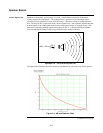
2-4
Sound is created by mechanical vibrations that displace air molecules to create repetitive changes
in air pressure. The ear detects these changes in air pressure, with the magnitude of the pressure
perceived as loudness and the frequency of the changes perceived as pitch.
Due to the physiology of the ear, sound pressure does not correlate directly to the perceived
loudness over all SPL and frequencies. The ear is most sensitive to frequencies between
3 to 5 kHz and much less sensitive to low frequencies. For a low frequency tone to be perceived
as loud as a high frequency sound, it must have a much higher SPL. In addition, the ear’s
sensitivity to the low frequencies also depends on the SPL. At high sound volumes, the loudness
difference between the most sensitive frequencies and low frequencies is reduced.
Figure 2-1. Robinson and Dadson Equal Loudness Curves
The equal loudness curves are used when sound levels are measured with a sound level meter.
If the meter has a “flat” response, then the displayed result shows a larger than perceived level
when sounds with significant low frequencies are measured. For this reason, sound level meters
have a correction or “weighting” filter built-in. This filter can more closely match the displayed
reading with the ear’s response. The most widely used weighting curve (and the one required by
NFPA 72) is the “A” weighted curve, which is approximately the inverse of the 40 phon equal
loudness curve. Meters configured with the “A” weighted filter read out in units of dBA, short for
“A” weighted decibels.
Other common weighting curves are the “B” and “C” curves, which approximate the ear’s
response at higher decibel levels. From a practical standpoint these curves are useful for
estimating the frequency content of the background noise during a room survey, but cannot be
used to validate the audibility of an emergency voice/alarm communications signal.
Note: The ear is capable of perceiving a difference in the sound level only when the sound level
has roughly doubled or halved. The dBA scale is a logarithmic scale, so a doubling of
sound power represents a 3 dBA increase in the SPL of the sound. Therefore, most
listeners can not perceive changes in SPL of less than 3 dBA. For a sound to be
perceived as twice as loud, the power must be increased 10 fold.
Sound and Hearing
The Relationship
Between Sound
and Hearing
The non-linear nature of the ear’s
response to frequencies and
loudness is well documented in
the Fletcher-Munson equal
loudness curves, updated in the
Robinson and Dadson equal
loudness curves that were adopted
in the ISO (International Standards
Organization) Recommendation
R-226.
Note: The MAF Curve in Figure 2-1
represents the “Minimum
Audible Field” Curve.


















